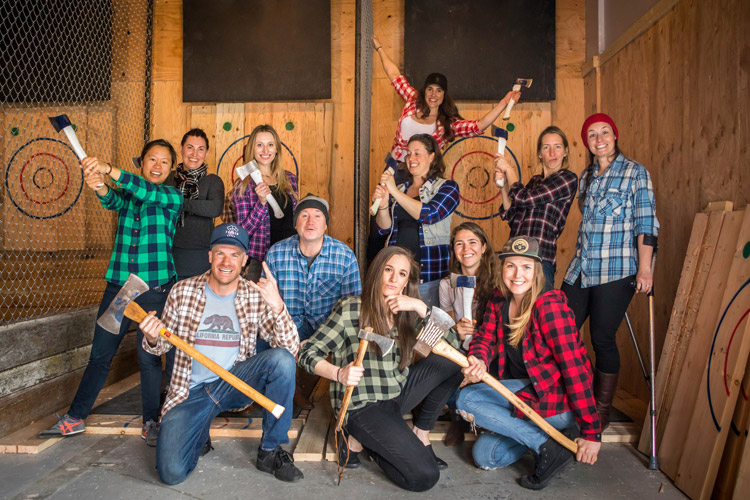The Enjoyable of Axe Throwing: Just How This Sport Combines Skill and Adrenaline for a Great Time
Axe throwing has actually emerged as a mesmerizing sporting activity that masterfully intertwines the need for exact ability with the thrill of adrenaline, offering individuals a unique and interesting experience. The act of tossing an axe towards a target requires concentration and method, all at once promoting an environment of camaraderie and friendly competition.
The Beginnings of Axe Throwing
Axe throwing, an entertainment activity that has actually gotten substantial popularity recently, traces its roots back to ancient times. This primal sport go back to early human history, when axes were mainly used as weapons and tools. The earliest records of axe usage in competitive contexts are discovered among the Celts and Vikings, that threw axes for sporting activity in addition to in combat training. The technique was not simply a pastime but an important skill for survival and war.
Medieval European warriors, particularly throughout the Center Ages, practiced axe tossing as component of their martial training. The Francisca, a kind of throwing axe utilized by the Franks, became renowned for its fatal precision. This conventional tool was made to be tossed at opponent guards and shield, showcasing its double energy in both sporting activity and fight.
In more recent background, axe tossing saw a rebirth in the logging camps of The United States and copyright in the 20th and 19th centuries. Lumberjacks would certainly participate in friendly competition, examining their precision and strength by focusing on wood targets. This advancement from a survival skill to a leisure task has actually paved the way for its modern resurgence, with devoted places and leagues now celebrating the sporting activity internationally.
Equipment You Need
Understanding the rich history of axe throwing improves the appreciation of the sport's modern-day iteration. For competitive and entertainment axe tossing, the most frequently utilized kind is the hatchet, commonly evaluating between 1.25 to 2 extra pounds with a take care of size of around 16 inches.
Equally essential is the target. Guideline targets are constructed from timber, with softwood ranges like ache or cottonwood being liked for their ability to hold the axe and take in. The target is usually split right into 5 concentric circles, each with a particular point value, to facilitate rating.
Safety gear, though usually neglected, is important. Safety handwear covers can boost grasp and avoid blisters, while closed-toed shoes are a should to safeguard feet from dropped axes (axe throwing denver). Ultimately, a well-lit, sizable throwing location, complete with security obstacles, guarantees a regulated setting where participants can concentrate on honing their go right here skills.
Fundamental Techniques Explained
Understanding the essential strategies of axe throwing is important for both security and proficiency. The dominant hand must be placed directly below the axe head, while the non-dominant hand sustains the end of the take care of.
Following, concentrate on the position. Stand with your feet shoulder-width apart, ensuring your body is stabilized. Your leading foot ought to be somewhat ahead, straightening with your target. This positioning help in preserving security and directing power properly in the direction of the target.

Safety First
Ensuring security in axe throwing is critical to creating an injury-free and delightful experience. Precaution start with the venue layout. A well-designed axe throwing center attributes clear demarcations in between throwing lanes, tough backdrops to catch roaming axes, and non-slip flooring to protect against crashes. Furthermore, ample lighting is critical to help participants maintain aesthetic accuracy and spatial recognition.
Benefits of Axe Throwing
Axe tossing offers a myriad of advantages that expand beyond easy entertainment. The repeated motion of tossing the axe also enhances hand-eye control and fine motor abilities.
Psychologically, axe tossing needs strategy, precision, and focus, making it a superb way to sharpen cognitive skills. The focus needed to hit the target can serve as a type of mindfulness, permitting individuals to remove their minds and reduce stress. This mental interaction can be particularly beneficial in assisting people create better problem-solving abilities and mental resilience.
Socially, axe throwing is typically enjoyed in team setups, cultivating team-building and camaraderie. Whether as component of a corporate occasion or a laid-back getaway with buddies, the sporting activity motivates interaction and collaboration. Additionally, the public experience of discovering and improving together can enhance connections and develop lasting memories.
Conclusion

The earliest documents of axe usage in competitive contexts are located amongst the Celts and Vikings, that threw axes for sporting activity as well as in battle training. Release the axe when your hands are approximately at eye degree, enabling the axe's natural turning to direct it towards the target.
A well-designed axe tossing center attributes clear separations between throwing lanes, tough backgrounds to catch stray axes, and non-slip floor covering to stop mishaps. Participants need to be advised on the right method to throw the axe and handle, stressing regulated, intentional motions over forceful tosses.
In summary, axe visit the site tossing stands out as a sport that masterfully integrates adrenaline, ability, and accuracy.